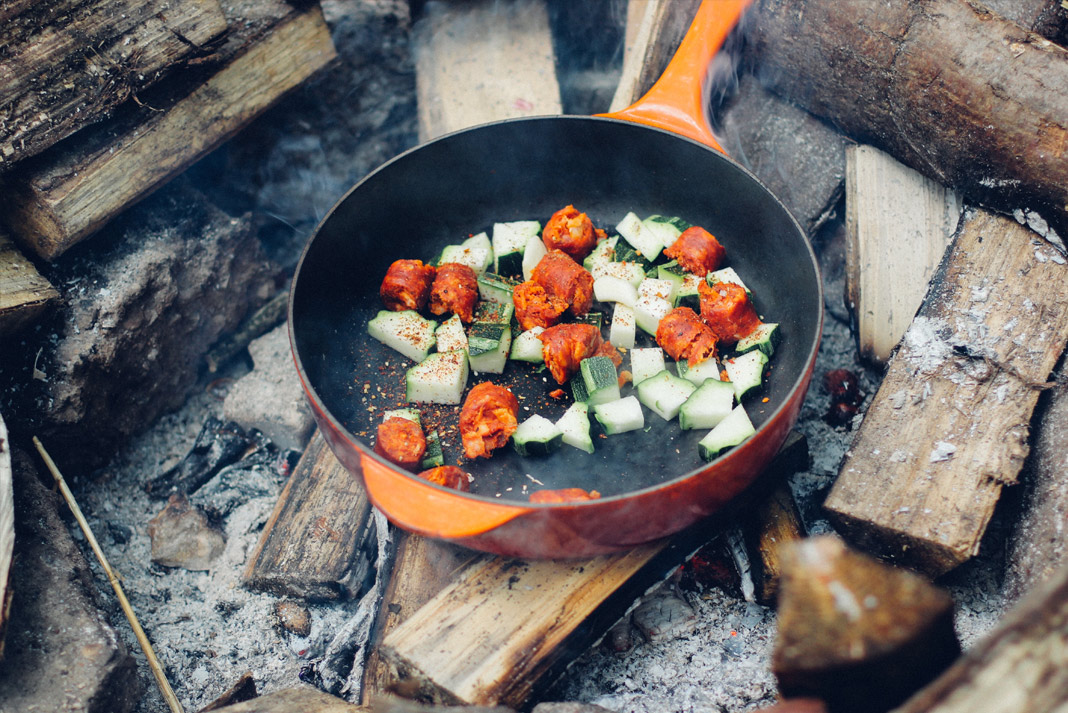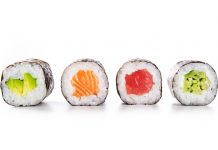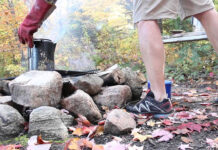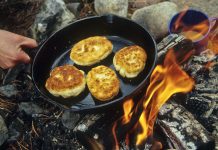Do you want to know the secret to cooking camping meals? With the right gear, prep and knowledge, your camping meals don’t actually have to be any different from your at-home kitchen meals. Anything you can cook at home, you can cook while camping. You just have to know how to do it!
Camping food ideas
The main things to consider when figuring out meals for your camping trip are what food to bring, how you will pack it and how you will keep it fresh.
If you are car camping, my advice is to pack two separate food containers—one being a cooler for veggies, meat or anything perishable, and the other being a large box for canned goods, dry goods, spices and non-perishable items. The best way to keep food fresh in the cooler is by reserving one-third of the cooler space for a large ice block, emptying the melted water from the ice out of your cooler twice daily, and replacing the ice block every three days.

If you are camping in the backcountry and don’t have space for a cooler and a large dry goods box, it is best to skip most of the perishable items. You should still pack veggies and hard meats and cheeses, but you must keep in mind the length of your trip and how long they will stay fresh. Going on a three-day backpacking trip in October? Your veggies, salami and cheese will be good to go for the whole trip. Going on a three-week kayak camping trip in June? You might just want to pack those perishables for the first few days, then plan for non-perishable foods after that.
Another thing to consider when deciding what food to bring camping is waste. No matter if you are far into the backcountry or car camping five meters away from a rubbish bin, the less waste you produce the better! This is why I always try to create camping recipes that produce as little waste as possible.
Finally, if you have any dietary restrictions, do not fret! Just like cooking in a kitchen, it is easy to make substitutions for any food intolerance or restriction you may have. You might have to do a bit more research to find the lightest-weight option out there, but it will be possible.
Campfire meals
Cooking over a campfire can have advantages and disadvantages.
Advantages
One advantage of cooking over a campfire is the elimination of carrying a stove. If you are trying to pack as light as possible, campfire meals might be your go-to. All you need is some dry tinder, wood and something to create a spark or flame (matches, lighter, fire starter, etc). You can then place a barbecue grate over the fire to cook meat and veggies, or skewer sausages on sticks and roast them over the fire.
Another advantage is the ability to cook with a Dutch oven. A Dutch oven is a large cast-iron pot with a cast-iron lid that you can use just like a regular kitchen oven. You simply fill the Dutch oven with whatever you are baking or cooking, place it over hot coals on a campfire, and set hot coals on the lid. With this method, you can bake/cook cinnamon rolls, cakes, roasted veggies, baked potatoes and even a whole roasted chicken!
Disadvantages
One disadvantage of cooking over a campfire is that it’s not always a feasible option. Many parts of the world have fire restrictions. Some areas have high fire danger due to drought, and have thus banned all campfires. Some national parks have banned campfires out of safety management practice. And some areas simply don’t allow them due to land management policies. Either way, it is important to heed these rules, so these areas remain open to public use.Another disadvantage to cooking over a campfire is that a Dutch oven is HEAVY! Dutch ovens are often reserved for car camping and rafting trips. Essentially, you should only bring one camping if weight isn’t an issue.
If cooking over a campfire isn’t your cup of tea, there are numerous options for camping stoves you can purchase. Anything from a small one-burner stove that weighs five ounces, to a large two-burner stove and grill can be purchased for camping.
Camping breakfast ideas
Want the easiest camping breakfast possible?
Boil two eggs, then use the hot water you just boiled the eggs in to make coffee and two packets of instant oatmeal. Add a banana with peanut butter if you still need more calories. High in protein and fibre, low in prep time and cleanup. If you eat the oatmeal straight out of the instant oatmeal packets they come in, you will literally only have to clean your coffee mug and spoon.
Want something with a bit more substance?
I like making toast over a camp grill or on a camp stove, then topping it with avocado, a fried egg (also cooked on a camp stove), and some nuts and seeds. This covers your carbohydrates, protein, and fats, and takes very little prep time. Add a piece of fruit on the side for a bit of a sugar boost in the morning.
Want a lightweight camping breakfast?
Instant oatmeal packets with powdered milk, powdered peanut butter, and dried fruit. Add a bit of honey or cocoa if you need a bit more flavor. It weighs next to nothing and will keep you full until lunch.
Want a breakfast you can cook over a campfire?
Simply skewer some sausages on sticks and roast them over the fire. And if you’re looking for something sweet, you can cook up some cinnamon rolls in the Dutch oven for a bonus.
Camping lunch ideas
The best camping lunches are the easiest lunches. You want to fit your lunch in a daypack or small drybag, so it is easily accessible on your adventures throughout the day. Sandwiches, snacks and easy soups are all good options.
If you are more keen for a big lunch on the river, you can always partake in Canada’s traditional “shore lunch.” A shore lunch is a wild fish fry on the edge of the river with fish that was just caught from the river itself. You’ll need to come prepared for this with fishing supplies, a skillet and stove, oil or butter, breading or flour for the fish, and any seasoning you prefer. Some good side dishes to go along with your shore lunch include potatoes, rice and veggies.
If you aren’t keen on fishing and setting up a stove for a shore lunch, other options include salami and hard cheeses, peanut butter and jelly sandwiches, trail mix, and hard-boiled eggs. Keep in mind nutrition requirements while packing your lunches in the backcountry. Don’t forget to get ample amounts of protein for energy through the rest of the day, and try to get some greens and fruit in there as well. Dried hummus with carrots is a good way to check both the protein and vegetable boxes in one.
Camping dinner ideas
The best camping meals for dinner are not camping meals at all. They are simply meals. Whatever you like to cook for dinner in your kitchen can also be cooked while camping.
One of the easiest camping dinners is a vegan stir-fry. Simply chop up an assortment of vegetables, saute them up with sesame oil and soy sauce, add some chickpeas or beans for protein, and serve with rice. Sprinkle sesame seeds and spring onions for more flavor.
The cheapest camping dinner also happens to be the cheapest camping breakfast. I call it “egg smash.” Simply put a bunch of random ingredients in a pan—veggies, beans, cheese, salami— cook it up, add a few eggs, and scramble it up! Easy and cheap.
If you are heading far into the backcountry and will no longer have perishable items with you, an easy backcountry camping dinner is macaroni and cheese (or any form of pasta with sauce) with dried beans or lentils added for protein.
It is extremely important on long backcountry trips to make sure you are getting an adequate amount of protein, even if it sometimes means a bit more weight in your backpack or kayak. Easy protein sources are cheese, nuts, beans, salami, lentils and nut butters.
Don’t forget the most important part of your camping dinner: dessert! Pack yourself a bar of high-quality dark chocolate to enjoy with tea after dinner. The better the chocolate, the less you will need, so get the good one!
Camping snacks
You don’t need to spend massive amounts of money on specialized protein bars to get your snack on while camping. Anything that is portable and ready-to-eat can be a good camping snack. The higher the calorie content, the better!
Here are some of the best and easiest snacks to bring into the backcountry:
- Hard-boiled eggs
- Pretzels
- Salami
- Hard cheesesNuts
- Dried fruit
- Dark chocolate
- Gummy candies (obviously)
- Pre-cooked bacon in a plastic sandwich bag
- Chocolate chip cookies
- Bananas (or any type of fruit)
- Anything dipped in peanut butter (carrots, oreos, apples, dark chocolate, cookies, pretzels…)
- Potato chips







